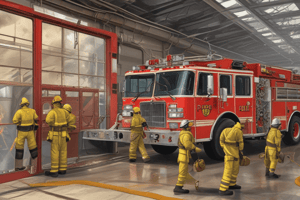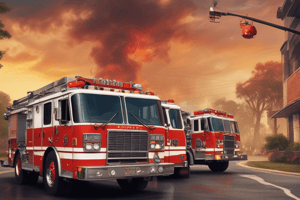Podcast
Questions and Answers
What is the primary responsibility of an Agency Representative at an incident?
What is the primary responsibility of an Agency Representative at an incident?
- To assist in the physical rescue operations.
- To delegate tasks to the Incident Command staff.
- To make decisions affecting their agency's participation. (correct)
- To manage the logistics of the incident.
Which of the following correctly describes an All-Call?
Which of the following correctly describes an All-Call?
- A coded message indicating resource allocation.
- A three series of three short blasts and a siren for evacuation. (correct)
- A signal used solely for training exercises.
- A continuous siren signaling for all units to return.
What distinguishes Assigned Resources from Available Resources?
What distinguishes Assigned Resources from Available Resources?
- Available Resources are not directly contributing to the incident.
- Assigned Resources have specific work tasks assigned. (correct)
- Available Resources have already been checked in.
- Assigned Resources are available for new tasks.
How is the Base defined in an incident context?
How is the Base defined in an incident context?
What is the role of the Chief in the Incident Command System?
What is the role of the Chief in the Incident Command System?
What does 'Clear Text' refer to in radio communications?
What does 'Clear Text' refer to in radio communications?
What is the function of the Command Post (CP) at an incident?
What is the function of the Command Post (CP) at an incident?
What is the primary responsibility of the Operations Section in incident management?
What is the primary responsibility of the Operations Section in incident management?
Which title refers to the Command Staff positions within the Incident Command System?
Which title refers to the Command Staff positions within the Incident Command System?
What is defined as the period scheduled for executing a set of operational actions?
What is defined as the period scheduled for executing a set of operational actions?
What is the main function of the Personnel Accountability Report (PAR)?
What is the main function of the Personnel Accountability Report (PAR)?
Which of the following best describes the National Incident Management System (NIMS)?
Which of the following best describes the National Incident Management System (NIMS)?
What does the Planning Section primarily focus on during an incident?
What does the Planning Section primarily focus on during an incident?
Who are considered Overhead Personnel in incident management?
Who are considered Overhead Personnel in incident management?
What characterizes Out-of-Service Resources during an incident?
What characterizes Out-of-Service Resources during an incident?
What is the primary responsibility of the Public Information Officer?
What is the primary responsibility of the Public Information Officer?
What does the term 'Redistricting' refer to in the context of incident management?
What does the term 'Redistricting' refer to in the context of incident management?
What is a 'Staging Area'?
What is a 'Staging Area'?
Who has the primary responsibility for monitoring safety hazards at an incident?
Who has the primary responsibility for monitoring safety hazards at an incident?
What defines 'Tactical Objectives' in incident operations?
What defines 'Tactical Objectives' in incident operations?
Which unit is primarily responsible for technical expertise during an incident?
Which unit is primarily responsible for technical expertise during an incident?
In the context of incident command, what role does a 'Supervisor' play?
In the context of incident command, what role does a 'Supervisor' play?
What is the focus of a Risk Management Plan (RMP)?
What is the focus of a Risk Management Plan (RMP)?
What best describes a leader in the ICS?
What best describes a leader in the ICS?
What is the initial stage?
What is the initial stage?
What is the difference between level 1 staging and level 2 staging?
What is the difference between level 1 staging and level 2 staging?
What is a division?
What is a division?
NFPA is the worlds leading advocate of fire prevention and an authoritative source on public safety, they develop, publish and disseminate more than ___ consensus codes and standards
NFPA is the worlds leading advocate of fire prevention and an authoritative source on public safety, they develop, publish and disseminate more than ___ consensus codes and standards
_____ establishes permissible exposure levels for hazardous materials
_____ establishes permissible exposure levels for hazardous materials
Officer is also used when a single individual preforms a ____ function with planning, logistics or finance
Officer is also used when a single individual preforms a ____ function with planning, logistics or finance
Technical specialists report initially to the _____ section but may be assigned anywhere within the ICS organizational structure as needed
Technical specialists report initially to the _____ section but may be assigned anywhere within the ICS organizational structure as needed
Flashcards
Agency Representative
Agency Representative
An individual holding full decision-making power for their agency during an incident, reporting to the Incident Liaison Officer.
All-Call
All-Call
A warning signal - three short blasts followed by a siren - indicating imminent danger.
Assigned Resources
Assigned Resources
Resources that have checked in and are assigned specific tasks during an incident.
Assisting Agency
Assisting Agency
Signup and view all the flashcards
Available Resources
Available Resources
Signup and view all the flashcards
Base
Base
Signup and view all the flashcards
Branch
Branch
Signup and view all the flashcards
Chief
Chief
Signup and view all the flashcards
Class A Assignment
Class A Assignment
Signup and view all the flashcards
Class C Assignment
Class C Assignment
Signup and view all the flashcards
Clear Text
Clear Text
Signup and view all the flashcards
Command Post (CP)
Command Post (CP)
Signup and view all the flashcards
Company
Company
Signup and view all the flashcards
National Incident Management System (NIMS)
National Incident Management System (NIMS)
Signup and view all the flashcards
Officer
Officer
Signup and view all the flashcards
Operational Period
Operational Period
Signup and view all the flashcards
Operations Section
Operations Section
Signup and view all the flashcards
Out-of-Service Resources
Out-of-Service Resources
Signup and view all the flashcards
Overhead Personnel
Overhead Personnel
Signup and view all the flashcards
Personnel Accountability Report (PAR)
Personnel Accountability Report (PAR)
Signup and view all the flashcards
Planning Meeting
Planning Meeting
Signup and view all the flashcards
Planning Section
Planning Section
Signup and view all the flashcards
Public Information Officer
Public Information Officer
Signup and view all the flashcards
Safety Officer
Safety Officer
Signup and view all the flashcards
Section
Section
Signup and view all the flashcards
Single Resource
Single Resource
Signup and view all the flashcards
Staging Area
Staging Area
Signup and view all the flashcards
Strategic Goals
Strategic Goals
Signup and view all the flashcards
Tactical Objectives
Tactical Objectives
Signup and view all the flashcards
Technical Specialist
Technical Specialist
Signup and view all the flashcards
Study Notes
EOG Glossary Overview
- Agency Representative: Individual with full decision-making authority for their agency at an incident, reports to the Incident Liaison Officer.
- All-Call: Evacuation alert rhythm—three short blasts followed by a siren—indicating imminent danger.
- Assigned Resources: Resources checked in and assigned specific tasks during an incident.
- Assisting Agency: Agency offering direct support or resources to another agency in an incident.
- Available Resources: Resources that are on-site and ready for assignment.
- Base: Main location for coordinating logistics, can also serve as the Incident Command Post, with only one Base per incident.
- Branch: Organizational level responsible for major operational segments at an incident, located between Section and Division/Group.
- Chief: ICS title for individuals leading the four functional Sections: Operations, Planning, Logistics, and Finance.
Incident Assignments
- Class A Assignment: Structural fire response requiring five engines, two ladders, and a district chief.
- Class C Assignment: Structural fire response consisting of four engines, one ladder, and a district chief.
- Clear Text: The practice of using plain English for all radio communications.
Command Structure
- Command Post (CP): Primary location for executing command functions, typically co-located with the Base.
- Company: Ground vehicle or equipment with a full complement of personnel (e.g., Engine, Ladder, Haz-Mat).
- National Incident Management System (NIMS): Framework ensuring collaboration among various governmental and organizational entities in emergency response.
- Officer: Title for key Command Staff positions within ICS, including Safety and Liaison roles.
Operational Functions
- Operational Period: Scheduled timeframe for executing specific actions outlined in the Incident Action Plan.
- Operations Section: Responsible for all tactical operations, including up to 5 Branches and 125 Single Resources.
- Out-of-Service Resources: Resources currently unavailable due to mechanical issues, personnel reasons, or rest requirements.
- Overhead Personnel: Supervisory positions including Incident Commander and Command Staff.
Incident Management and Reporting
- Personnel Accountability Report (PAR): Regular roll-call of personnel on scene to maintain accountability.
- Planning Meeting: Session held to develop specific strategies and tactics for an incident.
- Planning Section: Collects and disseminates incident information and resource status, overseeing situation and resource documentation.
Command and Safety
- Public Information Officer: Serves as the communication link with media and agencies for incident details; part of Command Staff.
- Safety Officer: Monitors safety hazards, assesses risks, and ensures personnel safety; also a member of Command Staff.
Additional Concepts
- Section: The organizational level responsible for operational functions, placed between Branch and Incident Commander.
- Single Resource: An individual Company or Crew assigned to tasks in an incident.
- Staging Area: Designated location for incident personnel and equipment awaiting assignment.
- Strategic Goals: Broad operational plans aimed at effective incident control, achieved through measurable tactical objectives.
- Tactical Objectives: Specific operations geared toward fulfilling strategic goals, designed to be precise and quantifiable.
- Technical Specialist: Skilled personnel activated as needed, often reporting to the Planning Section, with expertise in various specialized areas relevant to incident responses.
Studying That Suits You
Use AI to generate personalized quizzes and flashcards to suit your learning preferences.




